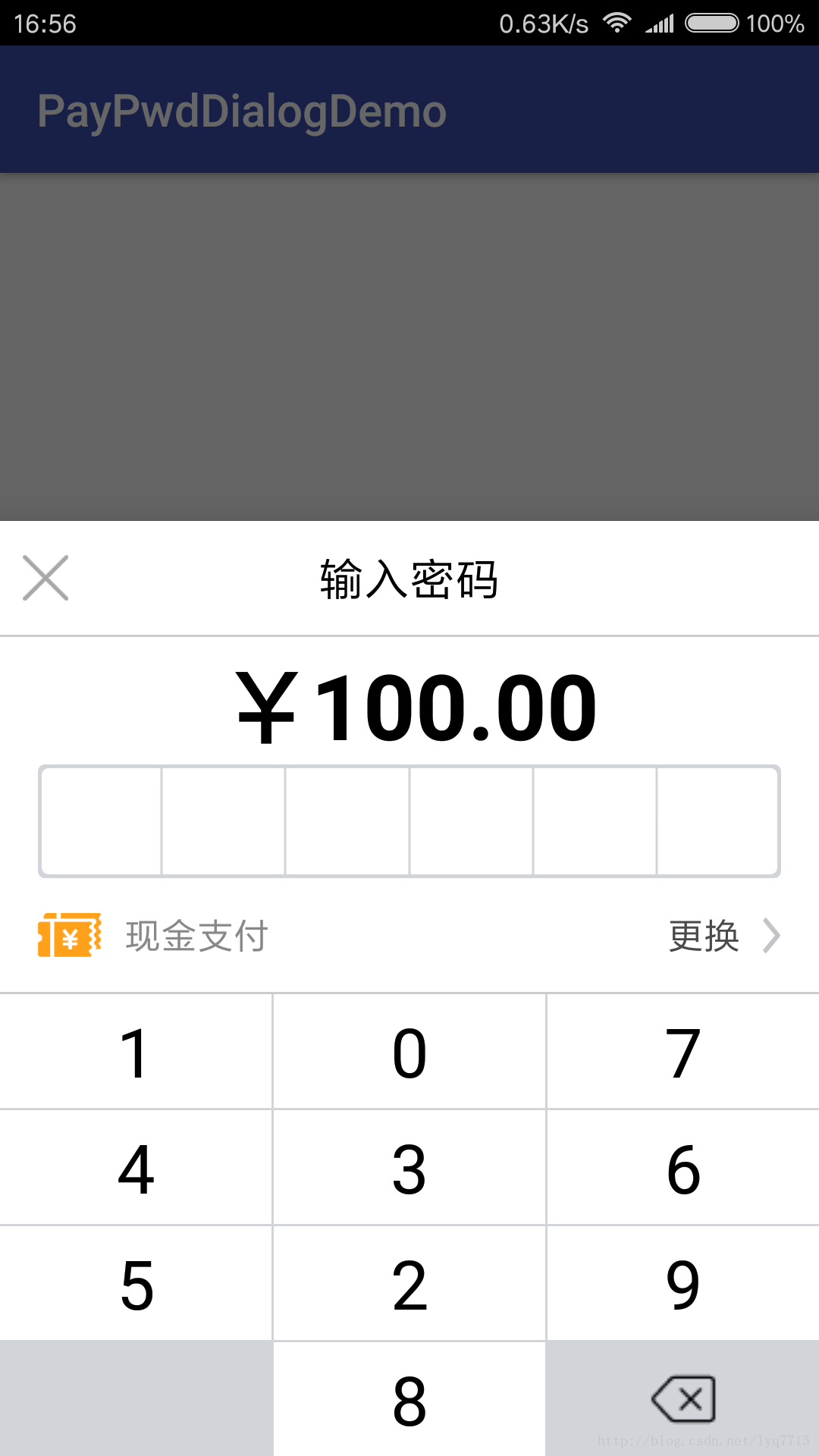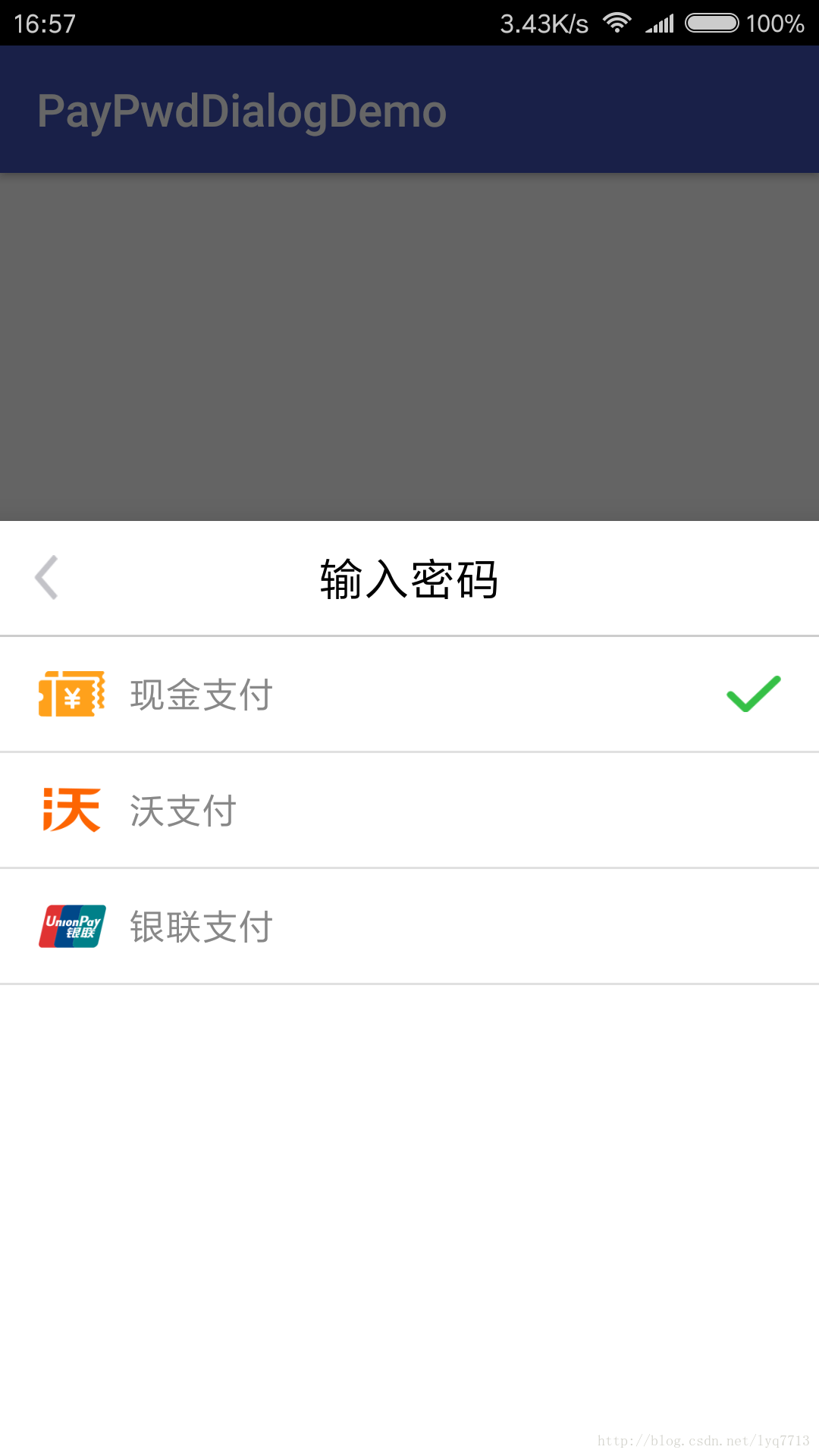жӮЁеҘҪпјҢзҷ»еҪ•еҗҺжүҚиғҪдёӢи®ўеҚ•е“ҰпјҒ
жӮЁеҘҪпјҢзҷ»еҪ•еҗҺжүҚиғҪдёӢи®ўеҚ•е“ҰпјҒ
иҝҷзҜҮж–Үз« дё»иҰҒдёәеӨ§е®¶еұ•зӨәдәҶвҖңAndroidеҰӮдҪ•е®һзҺ°д»ҝж”Ҝд»ҳе®қиҮӘе®ҡд№үеҜҶз Ғиҫ“е…ҘжЎҶеҸҠе®үе…Ёй”®зӣҳвҖқпјҢеҶ…е®№з®ҖиҖҢжҳ“жҮӮпјҢжқЎзҗҶжё…жҷ°пјҢеёҢжңӣиғҪеӨҹеё®еҠ©еӨ§е®¶и§ЈеҶіз–‘жғ‘пјҢдёӢйқўи®©е°Ҹзј–еёҰйўҶеӨ§е®¶дёҖиө·з ”究并еӯҰд№ дёҖдёӢвҖңAndroidеҰӮдҪ•е®һзҺ°д»ҝж”Ҝд»ҳе®қиҮӘе®ҡд№үеҜҶз Ғиҫ“е…ҘжЎҶеҸҠе®үе…Ёй”®зӣҳвҖқиҝҷзҜҮж–Үз« еҗ§гҖӮ
д№ӢеүҚеҒҡиҝҮзҡ„йЎ№зӣ®йҮҢжңүиҝҗз”ЁеҲ°дёҖдёӘж”Ҝд»ҳеңәжҷҜпјҡз”ЁжҲ·еҠһзҗҶдёҡеҠЎж—¶йңҖиҰҒиҫ“е…ҘдәӨжҳ“еҜҶз ҒпјҢ并且еҸҜж №жҚ®е№іеҸ°дёӢеҸ‘зҡ„ж”Ҝд»ҳж–№ејҸиҝӣиЎҢйҖүжӢ©гҖӮиҝҷдёҺж”Ҝд»ҳе®қзҡ„еҜҶз Ғиҫ“е…Ҙж–№ејҸеҚҒеҲҶзӣёдјјпјҢеҰӮжһңдҪҝз”ЁAndroidзі»з»ҹжҲ–иҖ…第дёүж–№иҪҜ件зҡ„й”®зӣҳпјҢдјҡжңүеҜҶз Ғжі„йңІзҡ„йЈҺйҷ©гҖӮеӣ жӯӨпјҢеӨ§еӨҡж•°зҡ„еә”з”ЁиҪҜ件дҪҝз”Ёзҡ„жҳҜиҮӘе®ҡд№үзҡ„еҜҶз Ғиҫ“е…ҘжЎҶеҸҠе®үе…Ёй”®зӣҳгҖӮ
з”ұдәҺеҜҶз Ғиҫ“е…Ҙж–№ејҸйңҖиҰҒе®һзҺ°дёҖдёӘд»Һеә•йғЁеј№еҮәзҡ„ж•ҲжһңпјҢеӣ жӯӨжҖ»дҪ“дёҠеҶіе®ҡйҮҮз”ЁBottomSheetDialogжқҘиҝӣиЎҢе°ҒиЈ…пјҢеҗҢж—¶дёәдәҶжҸҗй«ҳе®үе…ЁжҖ§пјҢиҝҳеә”иҜҘйҡҸжңәз”ҹжҲҗй”®зӣҳдёҠзҡ„ж•°еӯ—пјҢз•ҢйқўеҰӮдёӢеӣҫжүҖзӨәпјҡ


йҰ–е…Ҳж–°е»әдёҖдёӘPasswordInputViewзұ»пјҢе°ҶйңҖиҰҒдҪҝз”ЁеҲ°зҡ„ContextеҜ№иұЎгҖҒж”Ҝд»ҳйҮ‘йўқгҖҒеҸҜж”ҜжҢҒзҡ„ж”Ҝд»ҳж–№ејҸзӯүж•°жҚ®пјҢдҪңдёәиҜҘзұ»жһ„йҖ ж–№жі•зҡ„еҸӮж•°иҝӣиЎҢдј йҖ’гҖӮдёӢж–Үиҝҳе°ҶжҸҗеҲ°иҜҘзұ»жңүдёҖдёӘеӣһи°ғж–№жі•пјҢеҪ“з”ЁжҲ·иҫ“е…Ҙзҡ„еҜҶз Ғж»Ўи¶іе…ӯдҪҚж—¶пјҢеҸҜд»ҘеңЁеӣһи°ғж–№жі•дёӯиҺ·еҸ–еҜҶз Ғ并жҳҫзӨәеҮәжқҘгҖӮPasswordInputViewзұ»зҡ„жһ„йҖ ж–№жі•еҰӮдёӢжүҖзӨәпјҡ
public PasswordInputView(Context context, String payMoney, List<String> payWayList) { this.context = context; this.payMoney = payMoney; this.payWayList = payWayList; payPwdDialog = new BottomSheetDialog(context); View view = LayoutInflater.from(context).inflate(R.layout.dialog_pay_pwd, null, false); initStep1(view); initStep2(view); llyPwdInputView = (LinearLayout) view.findViewById(R.id.lly_pwd_input_view); llyPayWaySelect = (LinearLayout) view.findViewById(R.id.lly_pay_way_select); showStep1(); // жҳҫзӨә第дёҖйЎө }еӣ дёәдёҚиғҪжҳҺж–ҮжҳҫзӨәиҫ“е…Ҙзҡ„еҜҶз ҒпјҢжүҖд»ҘдҪҝз”ЁвҖңв—ҸвҖқжқҘд»ЈжӣҝжҜҸдҪҚеҜҶз ҒгҖӮиҮӘе®ҡд№үеҜҶз Ғиҫ“е…ҘжЎҶж¶үеҸҠеҲ°зҡ„иҮӘе®ҡд№үеұһжҖ§пјҢдё»иҰҒеҢ…жӢ¬пјҡиҫ“е…ҘжЎҶзҡ„еӨ§е°ҸгҖҒйўңиүІгҖҒеңҶи§’еҚҠеҫ„д»ҘеҸҠеҜҶз ҒеңҶзӮ№зҡ„еӨ§е°ҸгҖҒйўңиүІгҖҒеҚҠеҫ„гҖӮеӣ жӯӨпјҢиҮӘе®ҡд№үеұһжҖ§attrs.xmlж–Ү件еҰӮдёӢжүҖзӨәпјҡ
<?xml version="1.0" encoding="utf-8"?> <resources> <declare-styleable name="PasswordEditText"> <attr name="borderWidth" format="dimension"/> <attr name="borderColor" format="color"/> <attr name="borderRadius" format="dimension"/> <attr name="passwordLength" format="integer"/> <attr name="passwordWidth" format="dimension"/> <attr name="passwordColor" format="color"/> <attr name="passwordRadius" format="dimension"/> </declare-styleable> </resources>
жҺҘдёӢжқҘе°ұйңҖиҰҒеҺ»з»ҳеҲ¶иҮӘе®ҡд№үжҺ§д»¶дәҶгҖӮйҰ–е…ҲиҺ·еҸ–иҮӘе®ҡд№үеұһжҖ§пјҢ然еҗҺеңЁonDraw()дёӯиҝӣиЎҢз»ҳеҲ¶пјҢд»Јз ҒеҰӮдёӢжүҖзӨәпјҡ
package com.syd.paypwddialogdemo; import static android.graphics.Paint.ANTI_ALIAS_FLAG; import android.content.Context; import android.content.res.Resources; import android.content.res.TypedArray; import android.graphics.Canvas; import android.graphics.Color; import android.graphics.Paint; import android.graphics.RectF; import android.support.v7.widget.AppCompatEditText; import android.util.AttributeSet; /** * иҮӘе®ҡд№үеҜҶз Ғиҫ“е…ҘжЎҶ */ public class PasswordEditText extends AppCompatEditText { private int textLength; private int borderColor; private float borderWidth; private float borderRadius; private int passwordLength; private int passwordColor; private float passwordWidth; private float passwordRadius; private Paint passwordPaint = new Paint(ANTI_ALIAS_FLAG); private Paint borderPaint = new Paint(ANTI_ALIAS_FLAG); private final int defaultContMargin = 5; private final int defaultSplitLineWidth = 3; public PasswordEditText(Context context, AttributeSet attrs) { super(context, attrs); final Resources res = getResources(); final int defaultBorderColor = res.getColor(R.color.colorGray); final float defaultBorderWidth = res.getDimension(R.dimen.default_ev_border_width); final float defaultBorderRadius = res.getDimension(R.dimen.default_ev_border_radius); final int defaultPasswordLength = res.getInteger(R.integer.default_ev_password_length); final int defaultPasswordColor = res.getColor(R.color.colorBlack); final float defaultPasswordWidth = res.getDimension(R.dimen.default_ev_password_width); final float defaultPasswordRadius = res.getDimension(R.dimen.default_ev_password_radius); TypedArray a = context.getTheme().obtainStyledAttributes(attrs, R.styleable.PasswordEditText, 0, 0); try { borderColor = a.getColor(R.styleable.PasswordEditText_borderColor, defaultBorderColor); borderWidth = a.getDimension(R.styleable.PasswordEditText_borderWidth, defaultBorderWidth); borderRadius = a.getDimension(R.styleable.PasswordEditText_borderRadius, defaultBorderRadius); passwordLength = a.getInt(R.styleable.PasswordEditText_passwordLength, defaultPasswordLength); passwordColor = a.getColor(R.styleable.PasswordEditText_passwordColor, defaultPasswordColor); passwordWidth = a.getDimension(R.styleable.PasswordEditText_passwordWidth, defaultPasswordWidth); passwordRadius = a.getDimension(R.styleable.PasswordEditText_passwordRadius, defaultPasswordRadius); } finally { a.recycle(); } borderPaint.setStrokeWidth(borderWidth); borderPaint.setColor(borderColor); passwordPaint.setStrokeWidth(passwordWidth); passwordPaint.setStyle(Paint.Style.FILL); passwordPaint.setColor(passwordColor); } @Override protected void onDraw(Canvas canvas) { int width = getWidth(); int height = getHeight(); RectF rect = new RectF(0, 0, width, height); borderPaint.setColor(borderColor); canvas.drawRoundRect(rect, borderRadius, borderRadius, borderPaint); RectF rectIn = new RectF(rect.left + defaultContMargin, rect.top + defaultContMargin, rect.right - defaultContMargin, rect.bottom - defaultContMargin); borderPaint.setColor(Color.WHITE); canvas.drawRoundRect(rectIn, borderRadius, borderRadius, borderPaint); borderPaint.setColor(borderColor); borderPaint.setStrokeWidth(defaultSplitLineWidth); for (int i = 1; i < passwordLength; i++) { float x = width * i / passwordLength; canvas.drawLine(x, 0, x, height, borderPaint); } float cx, cy = height / 2; float half = width / passwordLength / 2; for (int i = 0; i < textLength; i++) { cx = width * i / passwordLength + half; canvas.drawCircle(cx, cy, passwordWidth, passwordPaint); } } @Override protected void onTextChanged(CharSequence text, int start, int lengthBefore, int lengthAfter) { super.onTextChanged(text, start, lengthBefore, lengthAfter); this.textLength = text.toString().length(); invalidate(); } public int getBorderColor() { return borderColor; } public void setBorderColor(int borderColor) { this.borderColor = borderColor; borderPaint.setColor(borderColor); invalidate(); } public float getBorderWidth() { return borderWidth; } public void setBorderWidth(float borderWidth) { this.borderWidth = borderWidth; borderPaint.setStrokeWidth(borderWidth); invalidate(); } public float getBorderRadius() { return borderRadius; } public void setBorderRadius(float borderRadius) { this.borderRadius = borderRadius; invalidate(); } public int getPasswordLength() { return passwordLength; } public void setPasswordLength(int passwordLength) { this.passwordLength = passwordLength; invalidate(); } public int getPasswordColor() { return passwordColor; } public void setPasswordColor(int passwordColor) { this.passwordColor = passwordColor; passwordPaint.setColor(passwordColor); invalidate(); } public float getPasswordWidth() { return passwordWidth; } public void setPasswordWidth(float passwordWidth) { this.passwordWidth = passwordWidth; passwordPaint.setStrokeWidth(passwordWidth); invalidate(); } public float getPasswordRadius() { return passwordRadius; } public void setPasswordRadius(float passwordRadius) { this.passwordRadius = passwordRadius; invalidate(); } }е®үе…Ёй”®зӣҳдё»иҰҒжҳҜйҖҡиҝҮGridViewжқҘе®һзҺ°пјҢдёҠж–ҮжҸҗеҲ°дёәдәҶдҝқиҜҒе®үе…ЁжҖ§пјҢеңЁе®үе…Ёй”®зӣҳеҲқе§ӢеҢ–зҡ„ж—¶еҖҷпјҢеә”иҜҘйҡҸжңәз”ҹжҲҗй”®зӣҳдёҠзҡ„ж•°еӯ—пјҢд»Јз ҒеҰӮдёӢжүҖзӨәпјҡ
/** * еҲқе§ӢеҢ–еҜҶз Ғй”®зӣҳ */ private void initKeyboard() { final int number = 10; int[] keys = new int[number]; for (int i = 0; i < 10; i++) { keys[i] = i; } // йҡҸжңәз”ҹжҲҗй”®зӣҳж•°еӯ— Random random = new Random(); for (int i = 0; i < number; i++) { int p = random.nextInt(number); int tmp = keys[i]; keys[i] = keys[p]; keys[p] = tmp; } numList = new ArrayList<>(); for (int i = 0; i < 12; i++) { Map<String, String> map = new HashMap<>(); if (i < 9) { map.put("num", String.valueOf(keys[i])); } else if (i == 9) { map.put("num", ""); } else if (i == 10) { map.put("num", String.valueOf(keys[9])); } else if (i == 11) { map.put("num", ""); } numList.add(map); } KeyAdapter keyAdapter = new KeyAdapter(context, numList, handler); gvKeyboard.setAdapter(keyAdapter); }е®үе…Ёй”®зӣҳзӮ№еҮ»дәӢ件зҡ„еӨ„зҗҶпјҢжҳҜеңЁйҖӮй…ҚеҷЁKeyAdapterзҡ„жһ„йҖ ж–№жі•дёӯдј е…ҘHandlerеҜ№иұЎпјҢйҖҡиҝҮ收еҸ‘ж¶ҲжҒҜзҡ„ж–№ејҸеңЁPasswordInputViewзұ»дёӯеӨ„зҗҶзҡ„пјҢд»Јз ҒеҰӮдёӢжүҖзӨәпјҡ
holder.btnKey.setOnClickListener(new View.OnClickListener() { @Override public void onClick(View v) { Message msg = new Message(); msg.what = Constants.KEYBOARD_INPUT; msg.obj = position; handler.sendMessage(msg); } });HandlerеҜ№иұЎеңЁPasswordInputViewзұ»дёӯе®ҡд№үпјҢдё»иҰҒз”ЁдәҺеӨ„зҗҶе®үе…Ёй”®зӣҳзҡ„зӮ№еҮ»дәӢ件пјҢд»Јз ҒеҰӮдёӢжүҖзӨәпјҡ
Handler handler = new Handler() { @Override public void dispatchMessage(Message msg) { switch (msg.what) { case Constants.KEYBOARD_INPUT: int position = (int) msg.obj; if (position < 11 && position != 9) { // зӮ№еҮ»0-9жҢүй”® password = etPwd.getText().append(numList.get(position).get("num")).toString(); etPwd.setText(password); } else { if (position == 11) { // зӮ№еҮ»йҖҖж јй”® if (!TextUtils.isEmpty(password) && !password.equals("")) { password = etPwd.getText().delete(password.length() - 1, password.length()).toString(); etPwd.setText(password); } } } break; } } };дёәдәҶж–№дҫҝеӨ–йғЁиҺ·еҸ–еҲ°з”ЁжҲ·иҫ“е…Ҙзҡ„еҜҶз ҒпјҢи®ҫи®ЎдёҖдёӘеӣһи°ғжҺҘеҸЈOnPwdInputListenerпјҢ并еңЁPasswordInputViewзұ»дёӯдёәеӣһи°ғжҺҘеҸЈеҲӣе»әдёҖдёӘsetж–№жі•пјҢд»Јз ҒеҰӮдёӢжүҖзӨәпјҡ
package com.syd.paypwddialogdemo; public interface OnPwdInputListener { void onPwdInput(String password); }еҪ“PasswordEditTextжҺ§д»¶зҡ„TextWatcherеҜ№иұЎзӣ‘еҗ¬еҲ°иҫ“е…Ҙзҡ„еҜҶз Ғж»Ўи¶іе…ӯдҪҚж—¶пјҢи°ғз”Ёеӣһи°ғж–№жі•пјҢе°ҶеҜҶз ҒдҪңдёәеҸӮж•°иҝӣиЎҢдј йҖ’пјҢд»Јз ҒеҰӮдёӢжүҖзӨәпјҡ
textWatcher = new TextWatcher() { @Override public void afterTextChanged(Editable s) { if (etPwd.getText().length() == 6) { onPwdInputListener.onPwdInput(etPwd.getText().toString()); } } }; etPwd.addTextChangedListener(textWatcher);еңЁеӨ–йғЁи°ғз”Ёsetж–№жі•пјҢеҲӣе»әOnPwdInputListenerеҜ№иұЎпјҢйҮҚеҶҷеӣһи°ғж–№жі•пјҢеҚіеҸҜиҺ·еҸ–еҲ°з”ЁжҲ·иҫ“е…Ҙзҡ„еҜҶз ҒпјҢд»Јз ҒеҰӮдёӢжүҖзӨәпјҡ
pwdInputView.setOnPwdInputListener(new OnPwdInputListener() { @Override public void onPwdInput(String password) { Toast.makeText(MainActivity.this, password, Toast.LENGTH_SHORT).show(); } });д»ҘдёҠжҳҜвҖңAndroidеҰӮдҪ•е®һзҺ°д»ҝж”Ҝд»ҳе®қиҮӘе®ҡд№үеҜҶз Ғиҫ“е…ҘжЎҶеҸҠе®үе…Ёй”®зӣҳвҖқиҝҷзҜҮж–Үз« зҡ„жүҖжңүеҶ…е®№пјҢж„ҹи°ўеҗ„дҪҚзҡ„йҳ…иҜ»пјҒзӣёдҝЎеӨ§е®¶йғҪжңүдәҶдёҖе®ҡзҡ„дәҶи§ЈпјҢеёҢжңӣеҲҶдә«зҡ„еҶ…е®№еҜ№еӨ§е®¶жңүжүҖеё®еҠ©пјҢеҰӮжһңиҝҳжғіеӯҰд№ жӣҙеӨҡзҹҘиҜҶпјҢж¬ўиҝҺе…іжіЁдәҝйҖҹдә‘иЎҢдёҡиө„и®Ҝйў‘йҒ“пјҒ
е…ҚиҙЈеЈ°жҳҺпјҡжң¬з«ҷеҸ‘еёғзҡ„еҶ…е®№пјҲеӣҫзүҮгҖҒи§Ҷйў‘е’Ңж–Үеӯ—пјүд»ҘеҺҹеҲӣгҖҒиҪ¬иҪҪе’ҢеҲҶдә«дёәдё»пјҢж–Үз« и§ӮзӮ№дёҚд»ЈиЎЁжң¬зҪ‘з«ҷз«ӢеңәпјҢеҰӮжһңж¶үеҸҠдҫөжқғиҜ·иҒ”зі»з«ҷй•ҝйӮ®з®ұпјҡis@yisu.comиҝӣиЎҢдёҫжҠҘпјҢ并жҸҗдҫӣзӣёе…іиҜҒжҚ®пјҢдёҖз»ҸжҹҘе®һпјҢе°Ҷз«ӢеҲ»еҲ йҷӨж¶үе«ҢдҫөжқғеҶ…е®№гҖӮ